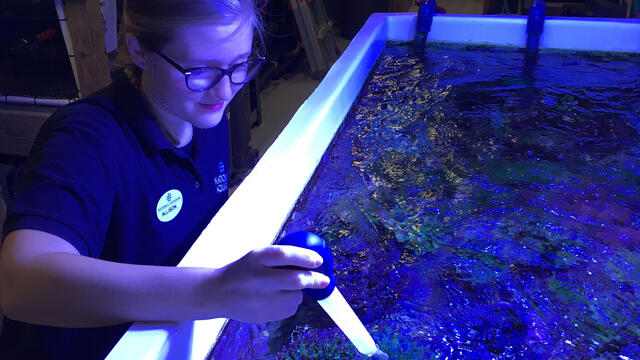Biology major immerses in National Aquarium internship
While gathering real-world experiences and exploring careers at the famed National Aquarium, senior Allison Parker also made a lot of friends — aquarists, herpetologists, conservationists and an eight-legged creature named Tallulah.

McDaniel College Biology major Allison Parker during her internship at the National Aquarium in Baltimore.
While gathering real-world experiences and exploring careers at the famed National Aquarium, senior Allison Parker also made a lot of friends — aquarists, herpetologists, conservationists and an eight-legged creature named Tallulah.
The Biology major from Columbia, Md., worked hard to earn Tallulah’s friendship, after learning that giant Pacific octopi do have their quirks. The first time they met, Tallulah wouldn’t eat or come to the surface of her habitat for food as long as Parker was standing with Tallulah’s caretaker, the aquarist who was Parker’s mentor.
Tallulah’s caretaker first speculated that she just didn’t recognize Parker’s face and was shy. Then they found out she had just shed her skin and probably was a bit embarrassed. On the final day of Parker’s 10-week aquarium internship, Tallulah rewarded Parker by not only accepting food but playing with her.
“When she grabbed me with a tentacle, it was so strong! I had to physically pull her off my arm and the suction of her tentacles actually made those cartoonish popping sounds.”
“When she grabbed me with a tentacle, it was so strong!” says Parker, who immersed in her work monitoring temperatures, salinity, chillers, pumps, filters and other life-supporting conditions and machines. “I had to physically pull her off my arm and the suction of her tentacles actually made those cartoonish popping sounds.”
Internships such as Parker’s offer students opportunities to test drive careers. Often it confirms a career choice — and sometimes the experience sends the student in a totally different direction. Either way it’s a glimpse at possibilities that lie ahead.
Although still sampling career opportunities, Parker learned about what it takes to be an aquarist and how to maintain various water habitats as well as assisting with large animal medical checks, introducing fish to the aquarium’s Atlantic Coral Reef and traveling around to explore other galleries such as the Jellies Invasion, Rainforest and Australia: Wild Extremes.
She sat in on talks by biologists in various exhibits and discovered that ancient giant sloths are the reason there are avocados today since the huge sloths were the only herbivores large enough to swallow avocados whole. Then, as they traveled far and wide and digested the avocados they “deposited” the pits which grew into trees.
Parker felt well prepared to dive into her work at the aquarium after taking organic chemistry and going on a McDaniel Jan Term course to the Bahamas to study coral reefs and their inhabitants. She received thorough job training and information about being an aquarist at the aquarium — and her mentor occasionally tested her on alkalinity and the nitrogen cycle.
Her view from behind the exhibits included both the typical day-to-day activities and the unexpected.
“While I was leading a behind-the-scenes tour, a girl leaned over a tank and she accidentally dropped her mother’s cell phone in,” she says. “Thankfully we were able to get the cell phone out and the tank was fine — but the phone was done for!”